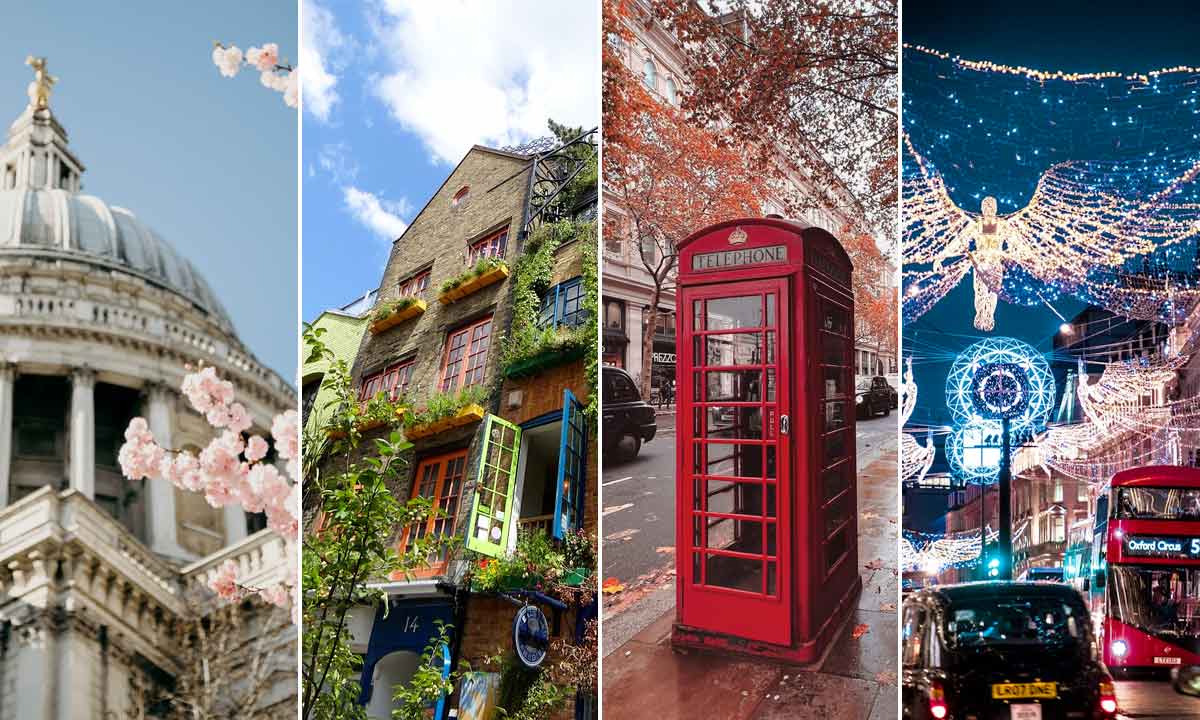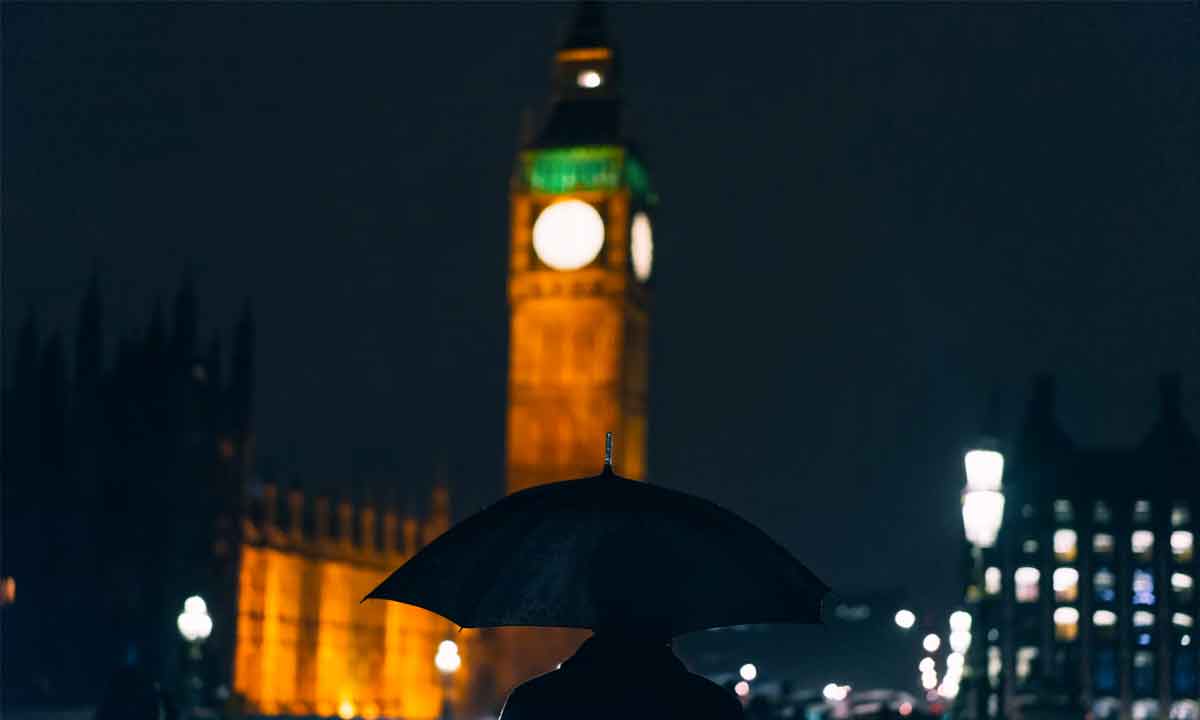London Weather Guide
Annual London Weather for Travellers with Detailed Seasonal and Monthly Forecasts

Welcome to your comprehensive guide to London weather, tailored for travellers. Whether you’re planning a summer holiday, a winter getaway, or a visit during the vibrant spring or colourful autumn (fall), understanding London’s weather is key to enjoying your trip to the fullest.
London Weather by Seasons
Explore London Weather by Season for detailed insights:
As London shakes off the winter chill, the city blooms in spring. Expect a mix of mild and occasionally wet days.
As London shakes off the winter chill, the city blooms in spring. Expect a mix of mild and occasionally wet days.
Crisp air and falling leaves characterise autumn. It’s a beautiful time to witness the changing colours of the city.
While it can be cold, winter in London has its own charm, especially around Christmas with festive lights and markets.
|
Season
|
Day Temp.
|
Night Temp.
|
Rainfall
|
Wind Speed
|
Humidity
|
|---|---|---|---|---|---|
|
11-15°C (52-59°F)
|
5-9°C (41-48°F)
|
50-55mm
|
13-19km/h (8-12mph)
|
55%–70%
|
|
|
20-23°C (68-73°F)
|
13-15°C (55-59°F)
|
45-50mm
|
11-17km/h (7-10mph)
|
50% – 65%
|
|
|
13-19°C (55-66°F)
|
8-11°C (46-52°F)
|
55-60mm
|
13-18km/h (8-11mph)
|
65% – 80%
|
|
|
6-8°C (43-46°F)
|
2-4°C (36-39°F)
|
50-55mm
|
14-20km/h (9-12mph)
|
70% – 85%
|

London Weather by Months
Dive deeper into London’s weather with our month-by-month breakdown. From the frosty days of January to the warm afternoons of July, each month offers a unique experience in the city.
Explore London Weather by Month for detailed insights:
Expect chilly and possibly wet weather with average temperatures around 8°C (46°F). It’s a great time for indoor attractions; pack warm clothing.
Similar to January, February is cold with average temperatures of 8°C (46°F). Ideal for enjoying London’s cosy pubs and indoor museums.
The arrival of spring brings milder weather with averages around 11°C (52°F). Lighter layers are suitable, and it’s a good time to start enjoying outdoor sights.
With average temperatures of 15°C (59°F), April sees London blooming. Pack a mix of light and warm layers, and don’t forget an umbrella for those April showers.
Warmer days average at 18°C (64°F). It’s a beautiful time to explore London’s parks and outdoor activities. Light layers and sunscreen are advisable.
Starting summer, June offers warmer weather averaging 21°C (70°F), with occasional days exceeding 30°C (86°F). Perfect for outdoor festivals and events; summer attire and sun protection are recommended.
The peak of summer, with averages around 23°C (73°F) and some days possibly surpassing 30°C (86°F). Enjoy the sun in London’s outdoors; hats, sunglasses, sunscreen & staying hydrated are essential.
Similar to July, August is warm, averaging 23°C (73°F), and can experience days above 30°C (86°F). Great for picnics in the park and open-air concerts. Stay hydrated and protected from the sun.
Early autumn brings mild weather, with averages around 20°C (68°F). A wonderful time for sightseeing as the city is less crowded. Light jackets are recommended.
Cooler temperatures return, averaging 15°C (59°F). Enjoy autumn’s beauty in London’s parks; pack layers and a light scarf.
Chilly days averaging 11°C (52°F). Explore indoor attractions like museums and galleries; warm clothing is a must.
Winter sets in with averages of 8°C (46°F). Experience festive London with Christmas markets; warm coats and layers are essential.
Monthly Averages
|
Month
|
Day Temp.
|
Night Temp.
|
Rainfall
|
Wind Speed
|
Humidity
|
|---|---|---|---|---|---|
|
8°C (46°F)
|
2°C (36°F)
|
55mm
|
15 km/h (9 mph)
|
85%
|
|
|
8°C (46°F)
|
2°C (36°F)
|
40mm
|
14 km/h (9 mph)
|
80%
|
|
|
11°C (52°F)
|
4°C (39°F)
|
40mm
|
14km/h (9mph)
|
75%
|
|
|
15°C (59°F)
|
6°C (43°F)
|
45mm
|
13km/h (8mph)
|
70%
|
|
|
18°C (64°F)
|
9°C (48°F)
|
50mm
|
13km/h (8mph)
|
65%
|
|
|
21°C (70°F)
|
12°C (54°F)
|
45mm
|
13km/h (8mph)
|
65%
|
|
|
23°C (73°F)
|
14°C (57°F)
|
45mm
|
12km/h (7mph)
|
60%
|
|
|
23°C (73°F)
|
14°C (57°F)
|
50mm
|
12km/h (7mph)
|
60%
|
|
|
20°C (68°F)
|
11°C (52°F)
|
50mm
|
14km/h (9mph)
|
70%
|
|
|
15°C (59°F)
|
8°C (46°F)
|
60mm
|
15km/h (9mph)
|
75%
|
|
|
11°C (52°F)
|
5°C (41°F)
|
60mm
|
16km/h (10mph)
|
80%
|
|
|
8°C (46°F)
|
3°C (37°F)
|
55mm
|
16km/h (10mph)
|
85%
|
London’s weather can be quite unpredictable, but that’s all part of the city’s charm. From misty mornings to bright afternoons, there’s always something to enjoy. No matter the weather, one of the best ways to see the city is from the comfort of a hop-on hop-off bus tour on a double decker sightseeing bus with an open top.
These tours allow you to explore iconic landmarks such as Buckingham Palace, the royal residence of King Charles III, the historic Tower of London with its Crown Jewels and famous Tower ravens, the impressive Tower Bridge over the River Thames, the architectural marvel of St. Paul’s Cathedral with its majestic dome, the iconic Big Ben clock tower and the Houses of Parliament, and the spectacular London Eye cantilevered observation wheel at your own pace.
With open-top buses, you can enjoy the fresh air and unobstructed views on sunny days. If it rains, you can sit downstairs in the covered section and continue to enjoy the sights in comfort. So, whether it’s sunny, rainy, or somewhere in between, hop on a sightseeing bus tour and see London in all its glory.

Monthly Events in London
Explore London’s Monthly Festivals and Events
Check out what you can see each month in London to fully experience its vibrant cultural scene.|
Month
|
Events and Festivals
|
|---|---|
|
London International Mime Festival
|
|
|
London Fashion Week
|
|
|
St. Patrick’s Day Parade (mid-March)
|
|
|
London Marathon
|
|
|
Chelsea Flower Show
|
|
|
Pride in London, Trooping the Colour
|
|
|
Wimbledon Tennis Championships
|
|
|
Notting Hill Carnival
|
|
|
Thames Festival, London Fashion Week, London Design Festival
|
|
|
Diwali on the Square, London Literature Festival
|
|
|
Bonfire Night, Lord Mayor’s Show
|
|
|
Christmas Markets (Winter Wonderland, Southbank Centre Winter Market)
|
Travel Tips and Advice for Visiting London
What to Pack
Your packing list for London will largely depend on the time of year you visit. Here are some essentials for each season:
- Spring (March to May): Bring layers – a combination of light tops, sweaters, and a waterproof jacket. The weather can be quite variable, so it’s good to be prepared for both cool and mild days.
- Summer (June to August): Pack lightweight and breathable clothing, sunglasses, and sunscreen. On hotter days, a hat and a refillable water bottle are also advisable.
- Autumn (Fall) (September to November): Include warm layers, a scarf, and a comfortable waterproof jacket. The weather can be unpredictable, ranging from warm days to chilly evenings.
- Winter (December to February): Essentials include a heavy coat, thermal wear, gloves, a scarf, and a warm hat. The weather is often cold, and it can be windy.
Staying Comfortable
Adapting to London’s varied climate is key to enjoying your trip:
- Stay Dry: An umbrella or a raincoat is a must year-round due to the city’s propensity for unexpected showers.
- Stay Warm: In colder months, cafes and museums are great places to stay warm and take breaks from the brisk outdoor weather.
- Stay Cool: During warmer months, seek out shade in one of London’s many parks, and stay hydrated, especially when sightseeing outdoors.
- Footwear: Comfortable walking shoes are a must, as London is best explored on foot. Ensure they are suitable for the weather – waterproof shoes for winter and cooler, breathable shoes for summer.
Navigating the City
London’s weather can impact how you get around the city:
- Public Transport: Familiarise yourself with the Tube, buses, and trains. They are efficient ways to travel, especially on rainy or very cold days. Remember, the Tube can be quite warm in the summer.
- Outdoor Activities: On clear days, consider a walking tour or a Thames river cruise to see the city from a different perspective.
- Cycling: Renting a bike is a great way to explore, but always be prepared for sudden changes in weather.
- Apps and Alerts: Use weather apps to check daily forecasts. This can help you plan your activities and choose the best mode of transport for the day.
Health and Safety
- Sun Protection: Even on cloudy days, UV rays can be strong. Don’t forget to apply sunscreen regularly.
- Stay Informed: Keep up-to-date with local news for any weather warnings or travel disruptions, especially in winter.
- Allergies: If visiting in spring or summer, be aware of pollen levels if you suffer from hay fever.

Best Time to Visit London
Deciding when to visit London largely depends on your personal preferences for weather, crowd levels, and the type of activities you enjoy. Each season in London has its unique charm and attractions.
Spring (March to May): This is a delightful time to visit, as the city starts to warm up and the parks and gardens come alive with spring blooms. The weather is milder, and the tourist crowds are generally smaller than in summer. It’s perfect for outdoor sightseeing and enjoying the city’s green spaces.
Summer (June to August): If you enjoy warmer weather, summer is ideal. London’s outdoor cafes, parks, and rooftop bars are bustling with activity. This is also when many festivals and outdoor events take place. However, be prepared for larger crowds and higher accommodation prices.
Autumn (Fall) (September to November): Autumn sees fewer tourists and offers mild weather. The changing colours of the city’s parks are a beautiful sight. It’s a great time for cultural events, theatre, and visiting museums and galleries.
Winter (December to February): If you don’t mind the cold and enjoy a festive atmosphere, winter could be your best bet. London during Christmas is magical, with its markets, lights, and holiday decorations. It’s also a good season for finding deals on flights and accommodation, except around Christmas and New Year.
General Advice:
- For Lower Crowds: Late spring and early autumn are ideal to avoid the peak tourist season while still enjoying pleasant weather.
- For Budget Travellers: Winter, excluding the Christmas period, often sees lower prices for flights and hotels.
- For Festivals and Events: Summer is bustling with cultural festivals, outdoor concerts, and events.
Ultimately, the best time to visit London is when it aligns with your interests and preferences. Whether it’s basking in the summer sun or enjoying the festive winter atmosphere, London has something special to offer in every season.
Frequently Asked Questions (FAQ) about London's Weather
How unpredictable is London's weather really?
London’s weather can be quite unpredictable. It’s not uncommon to experience several types of weather in one day. Therefore, it’s always wise to prepare for rain and shine.
Is London always rainy? Is there a dry season?
London’s climate doesn’t have a distinct dry season. The closest to a drier period would be late spring and summer months, particularly March, April, July, and August. However, even during these months, unpredictable showers are quite common, so it’s always wise to be prepared for rain.
Does it snow in London during winter?
Snow in London is relatively rare, and when it does snow, it seldom settles. However, be prepared for cold temperatures and occasional frosty mornings from December to February.
What is the best time of year to visit London weather-wise?
Many find late spring (May, early June) and early autumn (September) to be the best times to visit, as the weather is generally mild and pleasant.
Are there any extreme weather conditions to be aware of?
Extreme weather is rare in London. However, recent years have seen occasional heatwaves in summer and the odd storm in winter. Always check the forecast close to your travel date.
How does the weather affect public transport in London?
Generally, public transport in London runs efficiently regardless of the weather. However, severe weather conditions like heavy snow or storms can cause delays. Always check the service status, especially during winter months.
What should I wear if I'm visiting London in the summer?
Light clothing is advisable for the daytime. However, evenings can be cooler, so it’s a good idea to carry a light jacket or a sweater.
Are there any specific items I should bring for London's weather?
An umbrella or a waterproof jacket is essential year-round. Comfortable walking shoes are also recommended, as London is a city best explored on foot.
Can London's weather affect outdoor tourist activities?
Yes, it can. While many of London’s attractions are indoors, for outdoor activities, it’s best to have a flexible itinerary and check the weather forecast regularly.
How often should I check the weather forecast during my stay?
It’s a good idea to check the forecast daily. London’s weather can change quickly, and staying informed will help you make the most of your trip. Hourly changes can be checked throughout the day.
I forgot my umbrella/raincoat. Which shops sell those in London?
Umbrellas and raincoats can be found in many high street stores like Marks & Spencer, Primark, and John Lewis. Depending on the season, you can also find umbrellas in the pharmacy chain Boots. For foldable raincoats, which are easy to carry, check out outdoor shops like Cotswold Outdoor or Decathlon. Store maps can help you locate the nearest outdoor shop for convenient access.
I forgot to bring sunscreen. Where can I buy one in London?
Sunscreen is readily available in most pharmacies, supermarkets, and health and beauty stores. Boots and Superdrug are popular pharmacy chains with a wide range of sun protection products. You can also find sunscreens in supermarkets like Tesco, Sainsbury’s, and Waitrose, especially during the warmer months. These stores typically offer a variety of options to suit different skin types and preferences.
Additional Resources
For comprehensive insights into London’s weather, explore the following sections:
Seasonal Weather Guides for London:
- London Weather Guide
- Spring in London: March, April, May
- Summer in London: June, July, August
- Autumn / Fall in London: September, October, November
- Winter in London: December, January, February
Navigating London’s ever-changing weather and making the most of your visit requires access to the right resources. Here are some valuable tools and links to enhance your travel experience:
Weather Forecast and Updates
- Met Office: www.metoffice.gov.uk – The UK’s national weather service offers detailed forecasts and weather warnings.
- BBC Weather: www.bbc.co.uk/weather – Provides reliable weather forecasts and updates for London and surrounding areas.
- Weather.com: weather.com – For comprehensive weather forecasts including hourly and 10-day predictions.
- AccuWeather: www.accuweather.com – Offers local and long-range weather forecasts with real-time updates.
London Events, Attractions, and Activities
- Time Out London: www.timeout.com/london – Discover the latest events, activities, and attractions in London, suitable for every season.
- Visit London: www.visitlondon.com – The official visitor guide for upcoming events, exhibitions, and seasonal activities in London.
- The Travel Wiki: thetravel.wiki – Explore our blog for detailed guides on tours and attractions in London. Find information on daily tours to places like Bath, Windsor, Stonehenge, and the Harry Potter locations in London and the rest of the UK, as well as tours within or from London and various travel passes.
London’s weather is famously unpredictable, but that’s part of the city’s charm. Exploring London from a hop-on hop-off bus tour is a fantastic way to see the city, regardless of the weather.
These tours let you visit iconic landmarks like the London Eye, Buckingham Palace, the Tower of London, Tower Bridge, St. Paul’s Cathedral, Big Ben and the Houses of Parliament at your own pace.
No matter the season — whether it’s sunny, rainy, or somewhere in between — you can enjoy the open-top deck on warm days or move downstairs to the covered section if the weather turns.
From blooming spring to sunny summer, vibrant autumn, and festive winter, a hop-on hop-off sightseeing bus tour offers a comfortable and flexible way to experience London’s beauty throughout the year.

